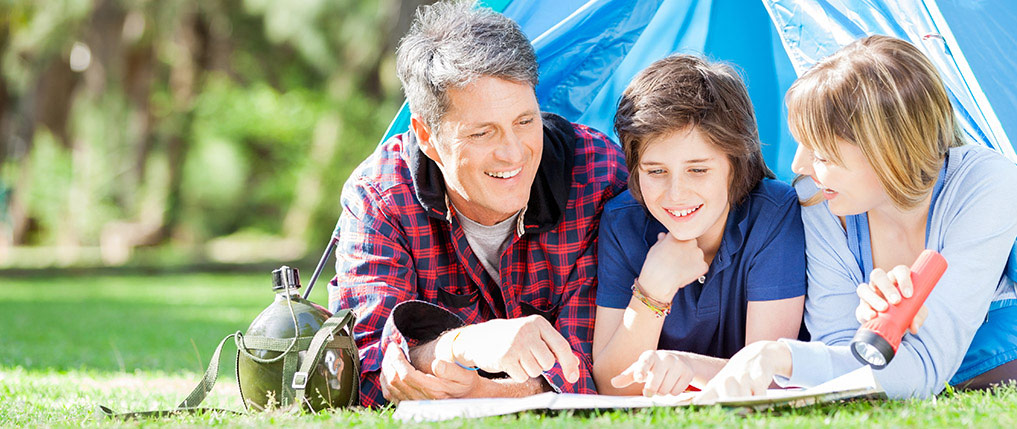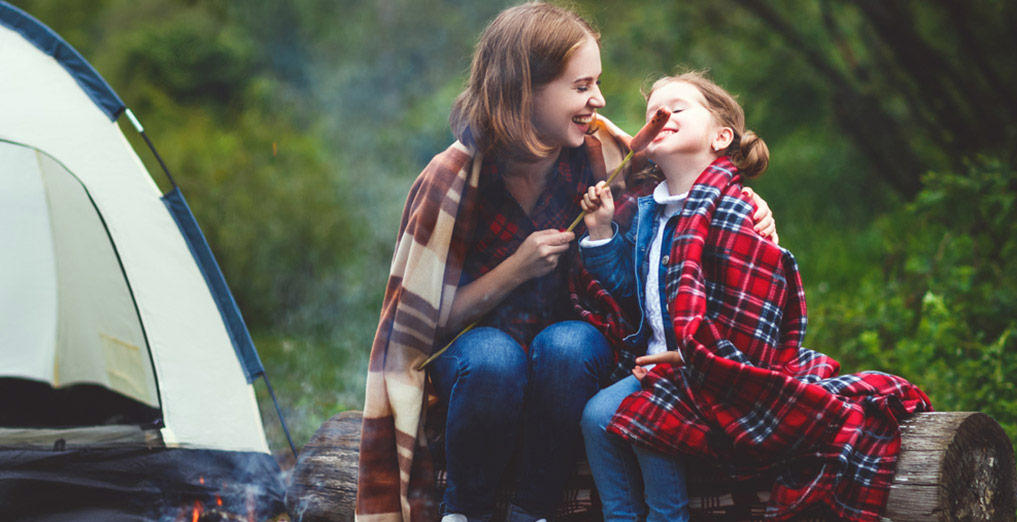Backyard Camping with Kids: How to Do it the Right Way
April 1, 2020

Camping is without a doubt one of the best ways to introduce your kids to the basic concepts of survival and outdoor stewardship. By taking them out of their typical environment and putting them somewhere new, you’re helping them to build self-confidence, problem-solving skills, independence and a spirit for adventure. The quality family bonding time is an added bonus! With no screens, no air conditioning and no pantry full of snacks, everything becomes a fun, family-centric activity when you’re out in the wild.
This year, as we enter the warm weather months reeling from a spring cooped up in the house, it’s going to be more important than ever to get outside and soak up some fresh air. Unfortunately, we still don’t know what will be on or off limits come camping season. Public and private campgrounds are closed across the country — many of the most popular national parks have temporarily closed or delayed opening of their campgrounds due to coronavirus — but that doesn’t mean camping is off the table. At least not if you’ve got a backyard!
In this guide, we’re going over all the fundamentals of backyard camping with kids, including the gear, the food and the activities to keep kids of all ages completely engaged.
The Basics
Before you set up camp out back, make sure to go through this list of basics. These are all the essentials you need to keep in mind before heading out on any camping journey, whether it’s on the lawn in the suburbs or the middle of the mountains.
- Wait for good weather…or don’t. A clear, dry day is the ideal time to pitch the tent, but Mother Nature is unpredictable and there’s probably a great lesson about adaptability buried somewhere in there. With proper shelter and warmth, you and your troop should be able to get through any weather system just fine. With that said, the backyard campout is often about introducing outdoor concepts to kids, so it’s totally fine if you want to start off small on a nice, dry day.
- Make it a “no phone zone.” We probably don’t have to tell you why it’s a great idea to make this a no-screen activity. As a parent, you already know that youngsters are digitally dialed-in the vast majority of the day, but stepping away can be extremely beneficial. Studies show that taking breaks from tech can help kids deepen connections, sleep better, learn better and be more productive overall.
- Everything’s a learning opportunity. Camping, whether in the backyard or deep in the off-grid wilderness, is about adapting. Teaching kids how to solve problems without every resource at their disposal can help them forge a sense of autonomy and self-confidence they’ll carry with them for a lifetime. Try to turn all challenges into learning opportunities for your kids.

- Make do with what you’ve got. Don’t automatically head inside to get something you need, with the exception of any emergency items or essentials. Part of the fun of camping is making do with whatever you were sensible enough to pack! Pack a hard cooler full of food and drinks and have the kids bring extra blankets and sweatshirts to prevent them from making trips in and out of the house.
- Use your imagination. Unfortunately, most of us don’t have acres of sprawling natural landscapes at our disposal, but that doesn’t mean we can’t teach our kids about the nature we do have. Take a neighborhood hike or turn the garden into a trail, introducing kids to native plants and animals every step of the way.
- Leave no trace. Sure, it’s your own property, but it’s still extremely important to teach kids to keep natural spaces natural. Throughout the activity, emphasize the importance of being kind to your surroundings and not leaving any permanent damage to the environment or wildlife. When you’re packing up, be sure to remove anything you brought outside so you leave it the way you found it.
The Gear: Shelter, Food and More
If you’re a seasoned camper, you probably already have everything you could ever need for a backyard campout in your garage or basement. Essentially, it’s like a dialed-down version of the real thing, so it shouldn’t involve any serious packing. With all the comforts of home just a few steps away, you don’t have to do nearly as much preparation as you would with a normal camping trip.
If you’re new to camping, you may have to invest in a couple of basics to get started. We always recommend borrowing a few things from a neighbor or friend for that first trial run before sinking hundreds into an activity you may not want to do ever again. Either way, here’s what you’ll need to buy or acquire:
- A Tent and Sleeping Bags — Choose a tent that’s big enough for everyone to sleep in but also has enough room for hanging out if the weather’s bad. The great thing about the backyard campout is that you don’t have to pack any clothes, so you should have some extra space inside the tent for games and hanging out. Don’t forget to involve the kids in the pitching process, as this is one of the most valuable camping lessons to learn on that very first outing!

- A Perfectly Packed Cooler — The cooler is an important part of keeping everyone outside throughout the night, since it prevents constant fridge runs for drinks or snacks. We always recommend our rolling hard coolers for these applications because they’re easy to roll out to camp and provide serious cooling power so everything stays fresh. To prevent soggy hot dog buns and water-logged cans, consider stocking yours with dry ice and using cooler baskets. Reference our guide on how to pack a cooler for more of the best cooler packing hacks.
- A Campfire — Campfires are the heart of the campsite. They’re the providers of warmth, light and — unless you want to lug out the camp stove — food. Investing in a portable backyard firepit or building one yourself can really transform a basic backyard into a full-blown campsite, and it’ll get plenty of use even when you’re not pitching a tent. Use the fire-building as a teaching opportunity to introduce the basics of fire to your kids. Don’t forget to bring out the lawn chairs!
- A Cast Iron Skillet or Grill Grate — Basic campfire cooking is a great backyard campout activity, as it doesn’t involve any complex equipment or gear. All you need is the campfire itself, a cooking grate and a cast iron skillet. With the right setup, you can turn your blazing fire into a full-blown stove or grill, whipping up hot dogs, burgers, grilled veggies, eggs, potatoes and so much more.
- Campfire Fare — Speaking of food… let’s talk about what, exactly, to pack in that handy cooler of yours. The best camping food is food that’s ready to eat or cook straight out of the cooler, with minimal prep needed (although we say make it as elaborate as you want). It should also be nutritionally dense since, in theory, you’ll be spending your time burning lots of energy while hiking, fishing and setting up camp out in the wild backyard. Whatever you do, don’t forget the s’mores stuff!
- A Flashlight or Headlamp — As night falls, you’re going to need a high-quality light source to help you cook, play games and keep camp in order. We always recommend packing both a flashlight and a headlamp so you have enough light no matter what you’re doing. Headlamps are especially ideal when you’re trying to cook, set up a tent or clean after dark, as they free up your hands for whatever you’re doing, but flashlights are nice when you need a direct, targeted light source.
- Binoculars — The most fun part about pitching a tent on your own property is discovering the things you didn’t even know were there. With a good pair of binoculars, you’ll be able to spot all the amazing, hidden gems in the neighborhood, including unique birds and trees. You might even consider bringing out the DSLR camera or drone to capture some great backyard nature shots.
- Field Guides — Every good outdoorsman or woman needs a set of field guides to help identify animals, insects and plants, including those that are edible, poisonous or otherwise interesting. Make sure your kids understand how to use field guides and then have them put their skills to use with a scavenger hunt (more on that below) to find unique wildlife in the neighborhood.

- A First Aid Kit — Since you’ll presumably only be a few feet away from your home and within close proximity to professional medical care, this one will hopefully be more for teaching and peace of mind than actually using. With that said, it’s always important to have a first aid kit on hand so you can quickly address cuts, bruises, scrapes and burns. Be sure yours is stocked with bandages, antiseptic wipes, gauze, antibiotic cream, a cold pack and other first aid basics.
The Fun and Games
Now that you’ve got the fundamentals of survival taken care of, it’s time for the fun part. Every good camping session should involve a bit of fun and games after a long, tiring day of setting up camp and hiking the backyard. Of course, your campout fun will depend on the age of your kids and what they’re into, but here are some of our favorite ideas to get you started.
- Do a Nature Scavenger Hunt — We’re not talking about placing clever clues around your property (though that would be fun, too). We’re talking about literally scavenging. Think: edible plants, mushrooms and morels, cool birds, fossils and other interesting rocks, seeds or anything else that you and your kids can discover throughout your property. Use your field guide to help identify your finds.
- Do Some Stargazing — There’s no better way to get your kids interested in astronomy than with a good, old-fashioned stargazing session in the backyard. If you have a telescope, consider bringing it out into the yard so you can get a better view of the stars and planets. Don’t forget to print out some astronomical charts or use a stargazing app so you can identify all the visible stars and constellations.
- Play Campfire Games — There are many great games that you can play while sitting around the campfire. Go around the circle and take turns answering interesting questions or playing games like telephone, truth or dare, 20 questions or two truths and a lie. You may even consider sharing funny or scary stories or breaking out the acoustic guitar for a fun campfire concert.
- Play Cards — What better time to teach your kids about card games? As one of the most fundamental forms of entertainment on the planet, card games provide fun when there are no screens, no electricity and nothing else to do. Make sure you have a comfortable place to play, like a well-lit picnic table or a folding card table.

Memories to Last a Lifetime
The truth is that there’s no “right way” to backyard camp. It doesn’t matter whether your version is a last-minute thought featuring your old, worn-out tent and whatever snacks you can toss in the cooler or a perfectly planned, well-orchestrated family activity. What matters is that you form positive memories with your children that will last for a lifetime.

SIGN UP FOR EXCLUSIVE OFFERS
Sign up for our newsletter and get exclusive access to new product launches, special offers and much more.
RELATED BLOGS














